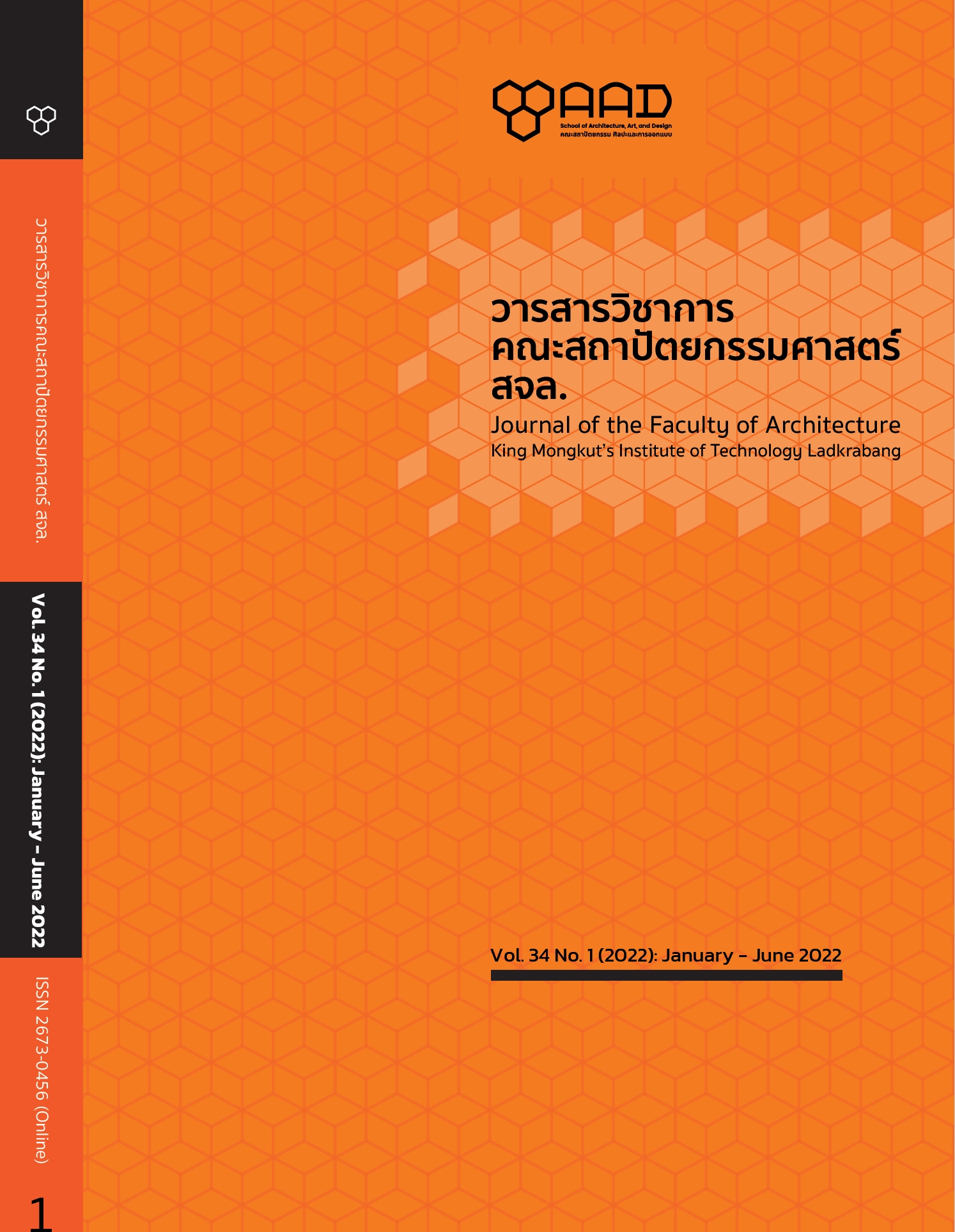A Design Guideline for House Rest or Lean Area to which Elderly People Against, based on a Survey of Degree of Fatigue while Strapping on a 6-to-18-month Baby Carrier
Main Article Content
Abstract
The objectives of this research were; 1) to study behaviors caused by being fatigued while strapping on a baby carrier in dwellings, 2) to obtain data about house wall patch to which elderly people can lean against, and 3) to propose a design guideline for house wall patch to which elderly people can lean against while strapping on a baby carrier. Data were collected from older adults with 60 years of age or above who live in Lat Krabang, Saphan Sung, and Min Buri districts, 10 persons per district, a total of 30 persons. Older adult volunteers from Lat Krabang, Saphan Sung, and Min Buri districts were selected from their willingness, 10 persons per district, a total of 3 persons. Data were collected from a dwelling survey using an interview and questionnaire for data analysis and synthesis of strapping on a baby carrier in dwellings among older adults.
The findings from the study revealed that 1) older adults carried a baby by holding a baby close to their chest (chest-to-chest contact). They often had pain and fatigue around their chest, shoulders, knees, hips and ankles while holding the baby, 2) the elderly most likely raised and held a baby in a living room with the size of (width*length* height) ~3.5 – 5 meters x ~3.5 – 5 meters x 2.5 meters in their house in their house and 3) a design guideline for house wall patch to which the elderly can lean against should follow the size of (width*length*height*depth: centimeter), i.e. 64 centimeters width, 64-78 centimeters length, 160-173 centimeters height, and 32 centimeters depth including installing a metal skeleton mounted to a wall, which can be adjusted to a high and low level so as to help lighten the baby’s weight from the posture the elderly use for holding a baby. Moreover, the material used should be able to bear the weight while resting or leaning against, i.e. the structure is lightweight and strong, materials used to cover the structure are soft, smooth, good for ventilation, easy for maintenance and can be used in a short period of time.
Article Details

This work is licensed under a Creative Commons Attribution-NonCommercial-NoDerivatives 4.0 International License.
This work is licensed under a Creative Commons Attribution-NonCommercial-ShareAlike 4.0 International License.
Copyright Transfer Statement
The copyright of this article is transferred to Journal of The Faculty of Architecture King Mongkut's Institute of Technology Ladkrabang with effect if and when the article is accepted for publication. The copyright transfer covers the exclusive right to reproduce and distribute the article, including reprints, translations, photographic reproductions, electronic form (offline, online) or any other reproductions of similar nature.
The author warrants that this contribution is original and that he/she has full power to make this grant. The author signs for and accepts responsibility for releasing this material on behalf of any and all co-authors.
References
Atthawuttikul, A and Khongkarat, S. (2021). Factors in Ergonomic Design of 6-to-18-month Baby Carriers for Elderly People. Pertanika Journal of Science and Technology. 29(2), 1097-1108.
Bleah, D. A. and Ellett, M. L. (2010). Infant crying among recent African immigrants. Health Care for Women International. 31(7), 652-663.
Brown, M. B., Digby-Bowl, C. J., and Todd, S. D. (2018). Assessing infant carriage systems: ground reaction force implications for gait of the caregiver. Human factors. 60(2), 160-171.
Doris, S. F. Yu., Diana, T. F. Lee., and Ng, Wai. Man., (2009). Fatigue among older people: A review of the research literature. International Journal of Nursing Studies. 47(2), 216-228.
Ekparinya, A. and Fusakul, S. (2011). Tile Surfaces forms against impact in Bathrooms for Elderly People. Architecture Journal of King Mongkut’s Institute of Technology Ladkrabang. 12(1), 45-56.
For-Wey Lung, Bih-Ching Shu, Tung-Liang Chiang, and Shio Jean Lin. (2008). Efficient Developmental screening instrument for 6-and 18-month-old children in the Taiwan Birth Cohort Pilot Study. Acta Paediatrica Nurturing the Child. 97(8), 1093-1098.
Goertz, G. (2008). Concepts, Theories, and Numbers: A Checklist for Constructing, Evaluating, and Using Concepts or Quantitative Measures. Political Science, Political Methodology, Comparative Politics, The Oxford Handbook of Political Methodology, September 2009.
Pajoodtakae, C., Phumichanteak, A., & Srimeanwai, P. (2019). Situation and Factors Associated with Early Childhood Nutritional status In Regional Health Area 9. Regional Health Promotion Center 9 Journal. 13(31): May-August 2019, 159-177.
Heavens A. (2004). Boomers Trend Toward ‘Age-In-Place’ Housing 2004. Retrieved from: http://realtytimes.com/rtcpages/20011011_ageinplace.
Howe Ann, L. (2003). Housing and older Australia: more of the same or something different? 2003. Keynote address to the Housing Futures in and Ageing Australia Conference, Melbourne: Sponsored by AHURi and the Myer Foundation, November 2003.
Jendreck, M. P. (1993). Grandparents who parent their grandchildren: Effects of lifestyle. Journal of Marriage and Family. 55(3), 609-621.
Pattanapongtorn, J. (2018). Report of the Study of Factors Affecting the Development of Thai Early Childhood Children No. 6, 2017. Department of Health, Ministry of Public Health. pp. 9-44.
Okochi, J. Utsunomiya, S. and Takahashi, T. (2005). Health measurement using the ICF: Test-retest reliability study of ICF codes and qualifiers in geriatric care. Health and Quality of Life Outcomes, 29 July 2005: 3-46.
Spanbroek, N. (2005). Opinion: Design profession and ageing in place. Australasian Journal on Ageing. 24(2), 69-70.
Tongdi, N., Inwan, C., Proytong, S., Kaewlomkai, J. and Deepong, C. (2021). Muscle pain and risk factors of muscle pain during the online learning and working from home among the students and staffs of Faculty of Public Health, Thammasat University, Lampang Campus. Thai Journal of Ergonomics. 4(1), 47-57.


